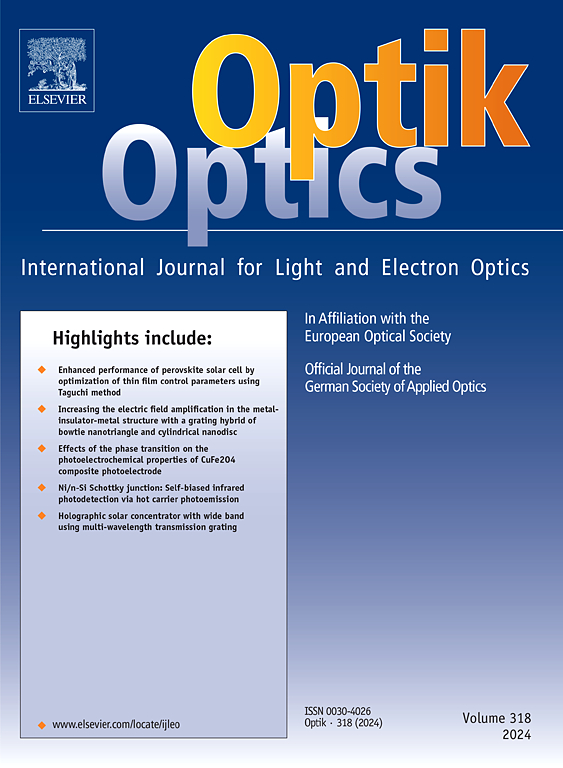一维光子晶体金属层集成增强疟疾生物传感器灵敏度
IF 3.1
3区 物理与天体物理
Q2 Engineering
引用次数: 0
摘要
基于光子晶体的生物传感器因其在生物医学诊断中的高灵敏度和超快响应而受到越来越多的关注。本文对两种用于疟疾检测的一维光子晶体(1D-PhC)结构进行了理论分析和性能比较。疟疾各阶段所对应的缺陷层折射率的变化导致缺陷模式透射峰的移位。利用传输矩阵法(TMM)计算透射谱。利用有限元工具COMSOL Multiphysics对PhC结构中的电场分布进行了研究。金属层在缺陷层两侧的集成提高了传感性能。研究了金属类型、金属层宽度、缺陷层折射率和入射角对TE和TM偏振的可调特性。金属-介电界面表面等离子体波的存在提高了对折射率微小变化的灵敏度,从而实现更有效的检测。这项工作的新颖之处在于开发了一种基于phc的疟疾检测生物传感器,该传感器使用小体积的样品缺陷具有足够的灵敏度和传播强度。银层传感器的灵敏度为265.2 nm/RIU,质量因子为1.35 × 102,分辨率为3.771 × 10−4 RIU,品质因数(FOM)为49 RIU−1,响应时间为18 fs,透射率为63 %。该结构的总厚度为3.12 μm,具有紧凑、经济的设计和超快的响应。本文章由计算机程序翻译,如有差异,请以英文原文为准。
Metal layer integration in one-dimensional photonic crystal for enhanced malaria biosensor sensitivity
Photonic crystal-based biosensors are attracting growing interest due to their high sensitivity and ultrafast response in biomedical diagnostics. We present a theoretical analysis and performance comparison of two one-dimensional photonic crystal (1D-PhC) structures aimed at malaria detection. The variation in the refractive index of the defect layer corresponding to various stages of malaria causes a shift in the transmission peak of the defect mode. The Transfer Matrix Method (TMM) is used to compute the transmission spectra. A Finite Element Method (FEM) tool COMSOL Multiphysics is used for studying the electric field distribution in the PhC structure. The integration of the metal layer on either side of the defect layer improved sensing performance. To investigate the tunable characteristics, variations were made in the type of metal, metal layer width, defect layer refractive index and incident angle for TE and TM polarisations. The presence of surface plasmon waves at the metal-dielectric interface enhances the sensitivity to small changes in the refractive index, enabling more effective detection. The novelty of the work includes the development of a PhC-based biosensor for malaria detection with sufficient sensitivity and transmission intensity using a small volume of sample defect. Sensor with silver layer achieved a sensitivity of 265.2 nm/RIU, a quality factor of 1.35 × 102, a resolution of 3.771 × 10−4 RIU, a figure of merit (FOM) of 49 RIU−1 and response time of 18 fs with transmission 63 %. The proposed structure has a total thickness of 3.12 μm and offers a compact, cost-effective design with ultrafast response.
求助全文
通过发布文献求助,成功后即可免费获取论文全文。
去求助
来源期刊

Optik
物理-光学
CiteScore
6.90
自引率
12.90%
发文量
1471
审稿时长
46 days
期刊介绍:
Optik publishes articles on all subjects related to light and electron optics and offers a survey on the state of research and technical development within the following fields:
Optics:
-Optics design, geometrical and beam optics, wave optics-
Optical and micro-optical components, diffractive optics, devices and systems-
Photoelectric and optoelectronic devices-
Optical properties of materials, nonlinear optics, wave propagation and transmission in homogeneous and inhomogeneous materials-
Information optics, image formation and processing, holographic techniques, microscopes and spectrometer techniques, and image analysis-
Optical testing and measuring techniques-
Optical communication and computing-
Physiological optics-
As well as other related topics.
 求助内容:
求助内容: 应助结果提醒方式:
应助结果提醒方式:


